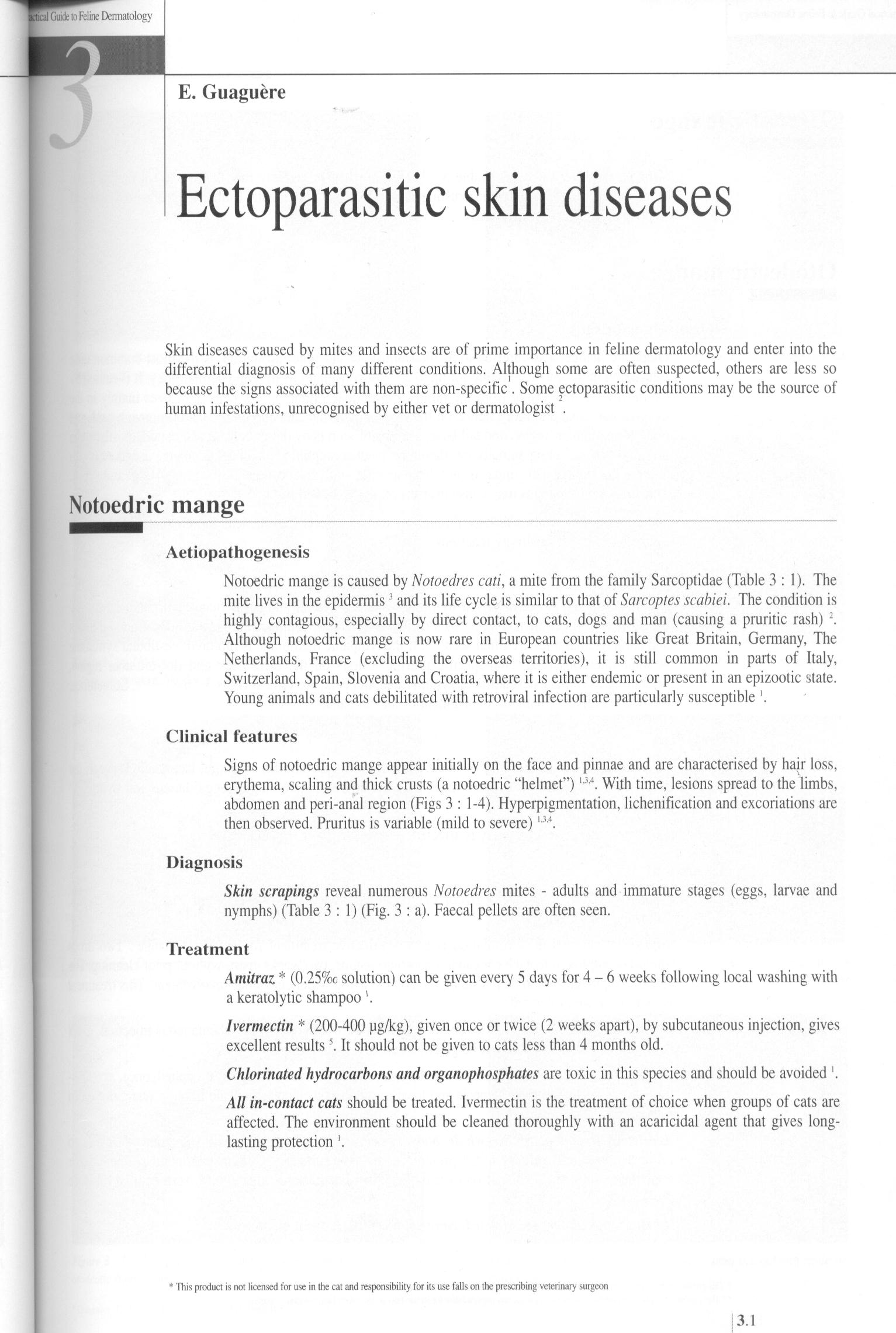3 (1496)

Guide to Feline Dermatolog)'
E. Guaguere
Ectoparasitic skin diseases
Skin diseases caused by mites and insects are of prime importance in feline dermatology and enter into the differential diagnosis of many different conditions. Although some are often suspected, others are less so because the signs associated with them are non-specific . Some ectoparasitic conditions may be the source of human infestations, unrecognised by either vet or dermatologist .
Notoedric mange
Aetiopathogenesis
Notoedric mange is caused by Notoedres cati, a mite from the family Sarcoptidae (Table 3:1). The mite lives in the epidermis1 and its life cycle is similar to that of Sarcoptes scabiei. The condition is highly contagious, especially by direct contact, to cats, dogs and man (causing a pruritic rash) 2. Although notoedric mange is now rare in European countries like Great Britain, Germany, The Netherlands, France (excluding the overseas territories), it is still common in parts of Italy, Switzerland, Spain, Slovenia and Croatia, where it is either endemic or present in an epizootie State. Young animals and cats debilitated with retroviral infection are particularly susceptible '.
Clinical features
Signs of notoedric mange appear initially on the face and pinnae and are characterised by hajr loss, erythema, scaling and thick crusts (a notoedric “helmet”) U4. With time, lesions spread to the limbs, abdomen and peri-anal region (Figs 3 : 1-4). Hyperpigmentation, lichenification and excoriations are then observed. Pruritus is variable (mild to severe) U4.
Diagnosis
Skin scrapings reveal numerous Notoedres mites - adults and immature stages (eggs, larvae and nymphs) (Table 3:1) (Fig. 3 : a). Faecal pellets are often seen.
Treatment
Amitraz 1 (0.25%o solution) can be given every 5 days for 4 - 6 weeks following local washing with a keratolytic shampoo'.
Ivermectin 1 (200-400 pg/kg), given once or twice (2 weeks apart), by subcutaneous injection, gives excellent results5. It should not be given to cats less than 4 months old.
Chlorinated hydrocarbons and organophosphates are toxic in this species and should be avoided \
Ali in-contact cats should be treated. Ivermectin is the treatment of choice when groups of cats are affected. The environment should be cleaned thoroughly with an acaricidal agent that gives long-lasting protection '.
This product is not licensed for use in the cat and responsibility for its use falls on the prescribing veterinary surgeon
3.1
Wyszukiwarka
Podobne podstrony:
54 (167) 5 A Practical Guide to Feline DermatologyClinical features The disease can present in three
48 (209) 4 A Practical Guide to Feline Dermatology Table 4:1: Type of hair invasion, fruiting bodies
67 (125) 6 A Practical Guide to Feline DermatologyNocardiosisAetiopathogenesis Nocardiosis is a very
69 (119) 6 A Practical Guide to Feline DermatologyDiagnosis The diagnosis is based on lesion distrib
42 (226) 4 A Practical Guide to Feline Dermatology Increased hydration and subsequent maceration of
58 (148) 5 A Practical Guide to Feline Dermatology severity of the illness. High titres are seen wit
65 (127) 6 A Practical Guide to Feline Dermatology Other topical antimicrobial agents, such as chlor
710 (2) 7 A Practical Guide to Feline DermatologyHerpesvirus infections Dermatological manifestation
74 (105) 7 A Practical Guide to Feline Dermatology ulcerated. Lesion distribution is multicentric bu
27 A Practical Guide to Feline Dermatology Perianal glands 1.7 Permethrin 3.12, 3.13 Persian 1.6,2.2
27 A Practical Guide to Feline Dermatology Stemphyllium spp. 5.1,7.8 Stereotypie behaviour 17.1,
272 (16) 27 A Practical Guide to Feline Dermatology Alternaria spp. 5.1,7.8 Aluminium hyroxide 15.6&
274 (18) 27 A Practical Guide to Feline Dermatology Colitis 11.2 Collagen 1.2,2.6,12.1,
278 (17) 27 A Practical Guide to Feline Dermatology I J Histoplasmosis 5.8, 7.8, 25.2 Homer’s syndro
28 (374) 2 A Practical Guide to Feline Dermatology Configuration of lesions Determining the configur
313 (14) A Practical Guide to Feline Dermatology The second phase consists of long-term control of t
31 (328) 3 A Practical Guide to Feline Dermatology Sarcoptic mange Sarcoptes scabiei var canis (Tabl
82 (128) 8 A Practical Guide to Feline Dermatology considered important parasites. Cats in the Unite
44 (228) 4 A Practical Guide to Feline Dermatolog) The term “asymptomatically infected cat” refers
więcej podobnych podstron